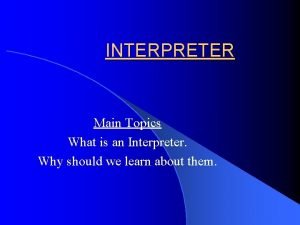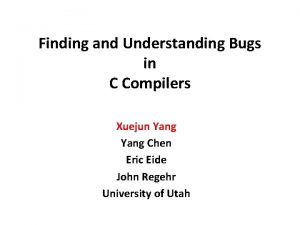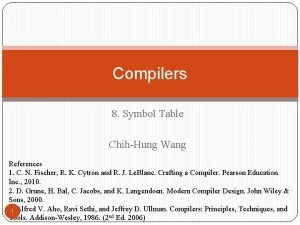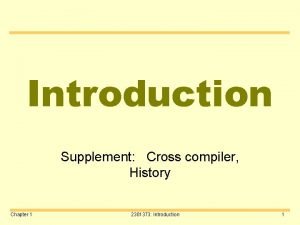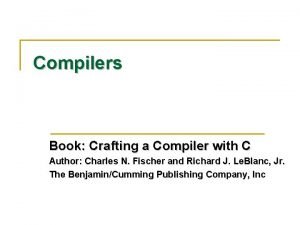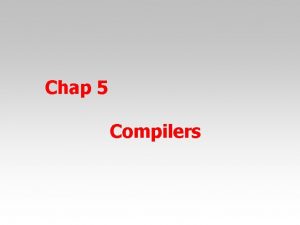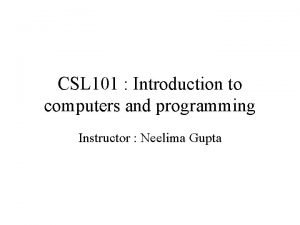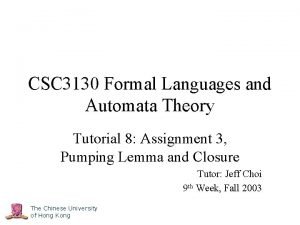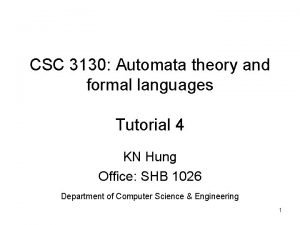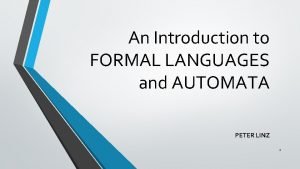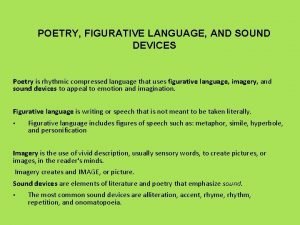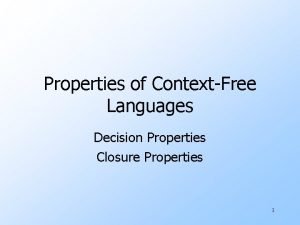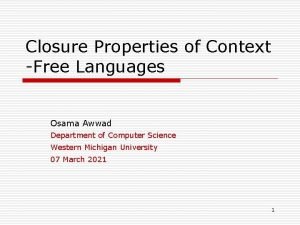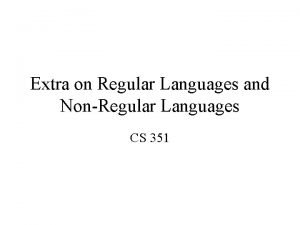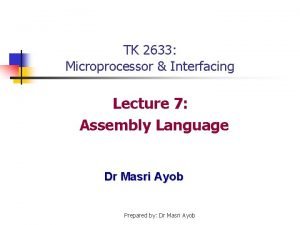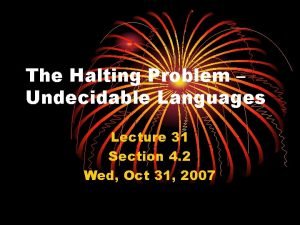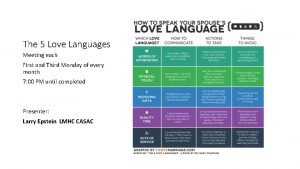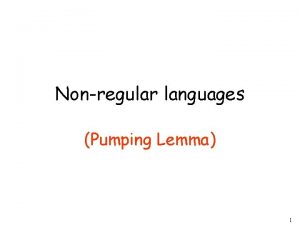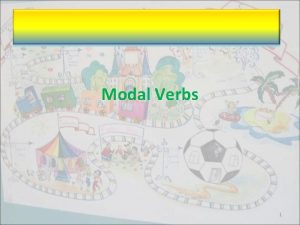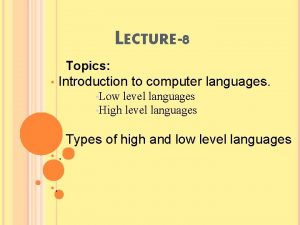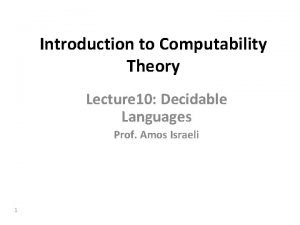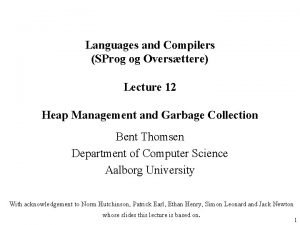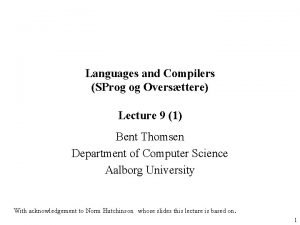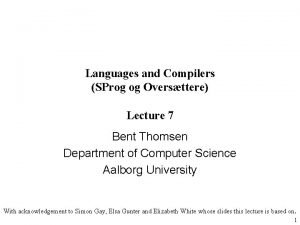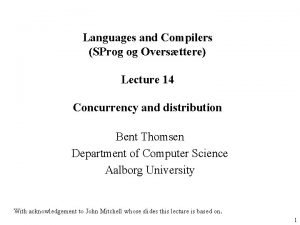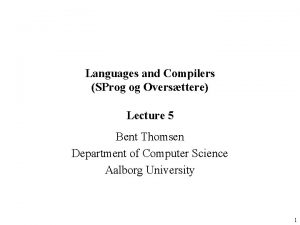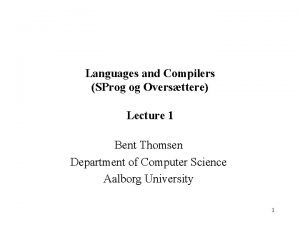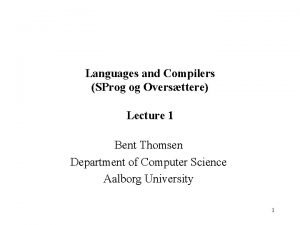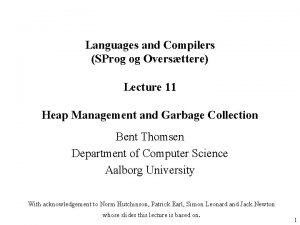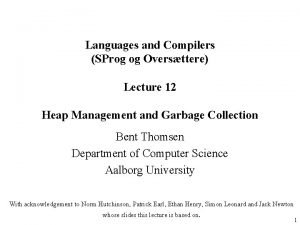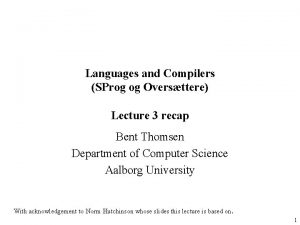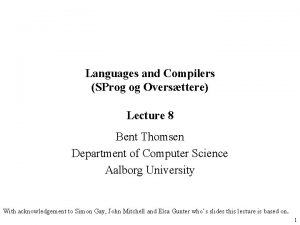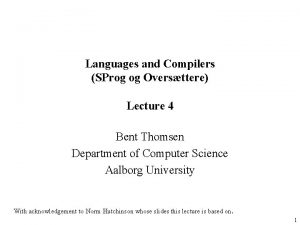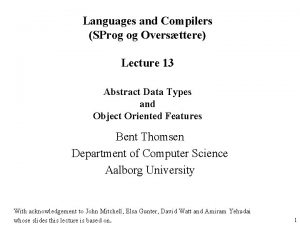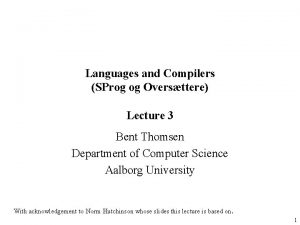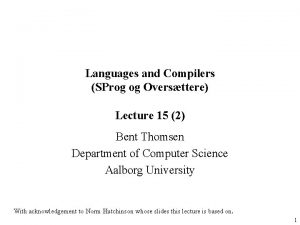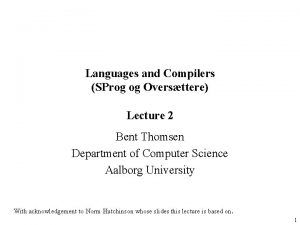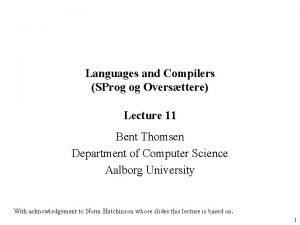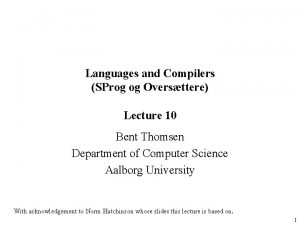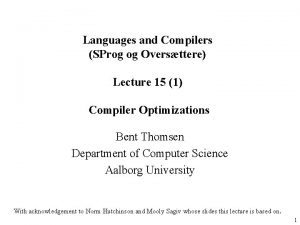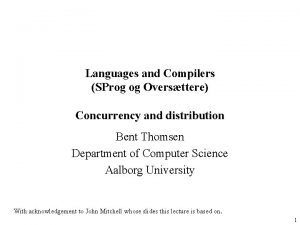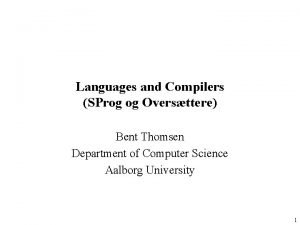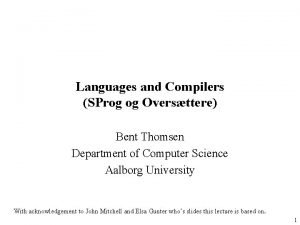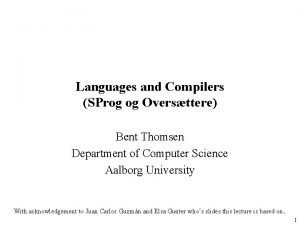Languages and Compilers SProg og Oversttere Lecture 8

























![C precedence levels • • • • • • Precedence Operators 17 tokens, a[k], C precedence levels • • • • • • Precedence Operators 17 tokens, a[k],](https://slidetodoc.com/presentation_image_h2/4f8b7931b17862bf7112a40903707ef2/image-26.jpg)






























![Multi-Way Conditional Selection • Non-deterministic Choice – Syntax: if <boolean guard> -> <statement> [] Multi-Way Conditional Selection • Non-deterministic Choice – Syntax: if <boolean guard> -> <statement> []](https://slidetodoc.com/presentation_image_h2/4f8b7931b17862bf7112a40903707ef2/image-57.jpg)


![Example • APPEND in Prolog: append([a, b, c], [d, e], X) • X = Example • APPEND in Prolog: append([a, b, c], [d, e], X) • X =](https://slidetodoc.com/presentation_image_h2/4f8b7931b17862bf7112a40903707ef2/image-60.jpg)




![Iterative Statements Ada: • Syntax: for var in [reverse] discrete_range loop. . . end Iterative Statements Ada: • Syntax: for var in [reverse] discrete_range loop. . . end](https://slidetodoc.com/presentation_image_h2/4f8b7931b17862bf7112a40903707ef2/image-65.jpg)
![Iterative Statements C: • Syntax: for ([expr_1] ; [expr_2] ; [expr_3]) statement – The Iterative Statements C: • Syntax: for ([expr_1] ; [expr_2] ; [expr_3]) statement – The](https://slidetodoc.com/presentation_image_h2/4f8b7931b17862bf7112a40903707ef2/image-66.jpg)























- Slides: 89

Languages and Compilers (SProg og Oversættere) Lecture 8 Bent Thomsen Department of Computer Science Aalborg University With acknowledgement to Simon Gay, John Mitchell and Elsa Gunter who’s slides this lecture is based on. 1

Correctness of Type Systems How does a language designer (or a programmer) know that correctly-typed programs really have the desired run-time properties? To answer this question we need to see how to specify type systems, and how to prove that a type system is sound. To do this we can use techniques similar to those from SOS To prove soundness we also need to specify the semantics (meaning) of programs - what happens when they are run. So studying types will lead us to a deeper understanding of the meaning of programs. 2

Formalizing Type Systems • The Triangle type system is extremely simple – Thus its typing rules are easy to understand from a verbal description in English • Languages with more complex type systems, such as SML, has a type system with formalized type rules – Mathematical characterizations of the type system – Type soundness theorems • Some languages with complex type rules, like Java, ought to have had a formal type system before implementation! – But a lot of effort has been put into creating formal typing rules for Java 3

How to go about formalizing Type systems • Very similar to formalizing language semantics with structural operational semantics • Assertions made with respect to the typing environment. Judgment: G |- t, where t is an assertion, G is a static typing environment and the free variables of t are declared in G Judgments can be regarded as valid or invalid. 4

Type Rules Type rules assert the validity of judgments on the basis of other judgments. • General Form (name) G 1 |- t 1 … Gn |- t n G |- t • If all of Gi |- ti hold, then G |- t must hold. 5

Example Type Rules (addition) G |- E 1: int, G |- E 2: int G |- E 1 + E 2: int (conditional) G |- E: bool, G |- S 1: T, G |- S 2: T G |- if E then S 1 else S 2: T (function call) G |- F: T 1 T 2, G |- E: T 1 G |- F(E): T 2 6

Very simple example • Consider inferring the type of 1 + F(1+1) where we know 1: int and F: int • 1 + 1: int by addition rule • F(1+1): int by function call rules • 1 + F(1 + 1) : int by addition rule 7

Type Derivations • A derivation is a tree of judgments where each judgment is obtained from the ones immediately above by some type rule of the system. • Type inference – the discovery of a derivation for an expression • Implementing type checking or type inferencing based on a formal type system is an (relatively) easy task of implementing a set of recursive functions (or recursive methods implementing the visitors interface). 8

Implementing type checking from type rules (conditional) G |- E: bool, G |- S 1: T, G |- S 2: T G |- if E then S 1 else S 2: T public Object visit. If. Expression (If. Expression com, Object arg) { Type e. Type = (Type)com. E. visit(this, null); if (! e. Type. equals(Type. bool. T) ) report error: expression in if not boolean Type c 1 Type = (Type)com. C 1. visit(this, null); Type c 2 Type = (Type)com. C 2. visit(this, null); if (! c 1 Type. equals(c 2 Type) ) report error: type mismatch in expression branches return c 1 Type; } 9

Connection with Semantics • Type system is sometimes called static semantics – Static semantics: the well-formed programs – Dynamic semantics: the execution model • Safety theorem: types predict behaviour. – Types describe the states of an abstract machine model. – Execution behaviour must cohere with these descriptions. • Thus a type is a specification and a type checker is a theorem prover. • Type checking is the most successful formal method! – In principle there are no limits. – In practice there is no end in sight. • Examples: – Using types for low-level languages, say inside a compiler. – Extending the expressiveness of type systems for high-level languages. 10

Attribute grammars as formalisation of type systems 11

Expressions 12

Statements Attribute grammars can be used to formalise (simple) type systems. Since AG are closely connected with actions in tools like JLex/CUP, Lex/Yacc and Java. CC this also suggests a possible alternative to implementing typechecking as a walk of the AST 13

Summary • Static typing is important • Type system has to be an integral part of the language design • There a lot of nitty-gritty decisions about primitive data types • Composite types are best understood independently of language manifestation to ensure correctness of implementation • Type systems can (and should) be formalised – Inference rules – Attribute grammers 14

Programming Language Design • Design criteria (again) • Lexical elements (again) • Syntactic elements – The long list of choices C Other languages If all you have is a hammer, then everything looks like a nail. 15

Criteria in a good language design • Readability – understand comprehend a computation easily and accurately • Write-ability – express a computation clearly, correctly, concisely, and quickly • Reliability – assures a program will not behave in unexpected or disastrous ways • Orthogonality – A relatively small set of primitive constructs can be combined in a relatively small number of ways – Every possible combination is legal – Lack of orthogonality leads to exceptions to rules 16

Criteria (Continued) • Uniformity – similar features should look similar and behave similar • Maintainability – errors can be found and corrected and new features added easily • Generality – avoid special cases in the availability or use of constructs and by combining closely related constructs into a single more general one • Extensibility – provide some general mechanism for the user to add new constructs to a language • Standardability – allow programs to be transported from one computer to another without significant change in language structure • Implementability – ensure a translator or interpreter can be written 17

Lexical Elements • • • Character set Identifiers Operators Keywords Noise words Elementary data • Comments • Blank space • Layout – Free- and fixed-field formats – numbers • integers • floating point – strings – symbols • Delimiters 18

Syntactic Elements • • • Definitions Declarations Expressions Statements Subprograms • • Separate subprogram definitions (Module system) Separate data definitions Nested subprogram definitions Separate interface definitions 19

Sequence control • Implicit and explicit sequence control – Expressions • Precedence rules • Associativity – Statements • Sequence • Conditionals • Iterations – Subprograms – Declarative programming • Functional • Logic programming 20

Expression Evaluation • Determined by – operator evaluation order – operand evaluation order • Operators: – Most operators are either infix or prefix (some languages have postfix) – Order of evaluation determined by operator precedence and associativity 21

Example • What is the result of: 3 + 4 * 5 + 6 • Possible answers: – – 41 47 29 77 = = ((3 + 4) * 5) + 6 3 + (4 * (5 + 6)) (3 + (4 * 5)) + 6 = 3 + ((4 * 5) + 6) (3 + 4) * (5 + 6) • In most languages, 3 + 4 * 5 + 6 = 29 • … but it depends on the precedence of operators 22

An Ambiguous Expression Grammar How to parse 3+4*5? <expr> <op> <expr> | const <op> + | * <expr> <op> <expr> + const * <expr><op><expr> const <expr><op> const + const * const 23

Expressing Precedence in grammar • We can use the parse tree to indicate precedence levels of the operators <expr> + <term> | <term> * const | const <expr> + <term> * const In LALR parsers we can specify Precedence which translates into Solving shift-reduce conflicts 24

Operator Precedence • Operators of highest precedence evaluated first (bind more tightly). Level Operator Operation Highest ** abs not Exp, abs, negation • Precedence for operators usually given in a table, e. g. : • In APL, all infix operators have same precedence * / mod rem Lowest +- Unary +-& Binary = <= < > => Relations And or xor Boolean Precedence table for ADA 25
![C precedence levels Precedence Operators 17 tokens ak C precedence levels • • • • • • Precedence Operators 17 tokens, a[k],](https://slidetodoc.com/presentation_image_h2/4f8b7931b17862bf7112a40903707ef2/image-26.jpg)
C precedence levels • • • • • • Precedence Operators 17 tokens, a[k], f(). , -> 16 ++, -15* ++, - , -, sizeof !, &, * 14 typename 13 *, /, % 12 +, 11 <<, >> 10 <, >, <=, >= 9 ==, != 8 & 7 6 | 5 && 4 || 3 ? : 2 =, +=, -=, *=, /=, %=, <<=, >>=, &=, =, |= 1 , Programming Language design and Implementation -4 th Edition Copyright©Prentice Hall, 2000 Operator names Literals, subscripting, function call Selection Postfix increment/decrement Prefix inc/dec Unary operators, storage Logical negation, indirection Casts Multiplicative operators Additive operators Shift Relational Equality Bitwise and Bitwise xor Bitwise or Logical and Logical or Conditional Assignment Sequential evaluation 26

Associativity • • • When we have sorted precedence we need to sort associativity! What is the value of: 7 – 5 – 2 Possible answers: – 7 In Pascal, C++, SML associate to the left – 5 – 2 = (7 – 5) – 2 = 0 In APL, associate to the right – 5 – 2 = 7 – (5 – 2) = 4 27

Again we can use syntax • Operator associativity can also be indicated by a grammar <expr> -> <expr> + <expr> | const (ambiguous) <expr> -> <expr> + const | const (unambiguous) <expr> + const In LALR parsers we can specify Associativity which translates into Solving shift-reduce conflicts <expr> + const 28

Special Associativity • In languages with built in support for infix exponent operator, it is standard for it to associate to the right: 2 ** 3 ** 4 = 2 ** (3 ** 4) • In ADA, exponentiation in non-associative; must use parentheses 29

Operand Evaluation Order • Example: A : = 5; f(x) = {A : = x+x; return x}; B : = A + f(A); • What is the value of B? • 10 or 15? 30

Example • If assignment returns the assigned value, what is the result of x = 5; y = (x = 3) + x; • Possible answers: 6 or 8 • Depends on language, and sometimes compiler – C allows compiler to decide – SML forces left-to-right evaluation • Note assignment in SML returns a unit value • . . but we could define a derived assignment operator in SML as fn (x, v)=>(x: =v; v) 31

Solution to Operand Evaluation Order • Disallow all side-effects – “Purely” functional languages try to do this – Miranda, Haskell – It works! – Consequence • No two-way parameters in functions • No non-local references in functions – Problem: • I/O, error conditions such as overflow are inherently sideeffecting • Programmers want the flexibility of two-way parameters (what about C? ) and non-local references 32

Solution to Operand Evaluation Order • Disallow all side-effects in expressions but allow in statements – Problem: not applicable in languages with nesting of expressions and statements 33

Solution to Operand Evaluation Order • Fix order of evaluation – SML does this – left to right – Problem: makes some compiler optimizations hard to impossible • Leave it to the programmer to be sure the order doesn’t matter – Problem: error prone 34

Short-circuit Evaluation • Boolean expressions: • Example: x <> 0 andalso y/x > 1 • Problem: if andalso is ordinary operator and both arguments must be evaluated, then y/x will raise an error when x = 0 • Similar problem for conditional expressions • Example (x == 0)? 0: sum/x 35

Boolean Expressions • Most languages allow (some version of) if…then…else, andalso, orelse not to evaluate all the arguments • if true then A else B – doesn’t evaluate B • if false then A else B – doesn’t evaluate A • if b_exp then A else B – Evaluates b_exp, then applies previous rules 36

Boolen Expressions • Bexp 1 andalso Bexp 2 – If Bexp 1 evaluates to false, doesn’t evaluate Bexp 2 • Bexp 1 orelse Bexp 2 – If Bexp 1 evaluates to true, doesn’t evaluate Bexp 2 37

Short-circuit Evaluation – Other Expressions • Example: 0 * A = 0 • Do we need to evaluate A? • In general, in f(x, y, …, z) are the arguments to f evaluated before f is called and the values are passed? Or are the unevaluated expressions passed as arguments to f allowing f to decide which arguments to evaluate and in which order? 38

Eager Evaluation • If a language requires all arguments to be evaluated before a function is called, the language does eager evaluation and the arguments are passed using pass by value (also called call by value) or pass by reference 39

Lazy Evaluation • If a language allows a function to determine which arguments to evaluate and in which order, the language does lazy evaluation and the arguments are passed using pass by name (also called call by name) 40

Lazy Evaluation • Lazy evaluation is mainly done in purely functional languages • Some languages support a mix • The effect of lazy evaluation can be implemented in functional languages with eager evaluation – Use thunking fn()=>exp and pass function instead of exp 41

Infix and Prefix • • • Infix notation: Operator appears between operands: 2 + 3 5 3 + 6 9 Implied precedence: 2 + 3 * 4 2 + (3 * 4 ), not (2 + 3 ) * 4 Prefix notation: Operator precedes operands: + 2 3 5 + 2 * 3 5 (+ 2 ( * 3 5 ) ) + 2 15 17 Prefix notation is sometimes called Cambridge Polish notation – used as basis for LISP 42

Polish Postfix • Postfix notation: Operator follows operands: • 2 3 + 5 • 2 3 * 5 + (( 2 3 * 5 +) 6 5 + 11 • Called Polish postfix since few could pronounce the Polish mathematician Lukasiewicz, who invented it. • An interesting, but unimportant mathematical curiosity when presented in 1920 s. Only became important in 1950 s when Burroughs rediscovered it for their ALGOL compiler. 43

Arithmetic Expressions • Design issues for arithmetic expressions: 1. What are the operator precedence rules? 2. What are the operator associativity rules? 3. What is the order of operand evaluation? 4. Are there restrictions on operand evaluation side effects? 5. Does the language allow user-defined operator overloading? • C++, Ada allow user defined overloading • Can lead to readability problems 6. What mode mixing is allowed in expressions? • Are operators of different types, e. g. int and float allowed • How is type conversion done 44

Assignment Statements • Simple assignments: – A = 10 or A : = 10 or A is 10 or =(A, 10) – In SML assignment is just another (infix) function • : = : ‘‘a ref * ‘‘a -> unit • More complicated assignments: 1. Multiple targets (PL/I) A, B = 10 2. Conditional targets (C, C++, and Java) (first==true)? total : subtotal = 0 3. Compound assignment operators (C, C++, and Java) sum += next; 45

Assignment Statements • More complicated assignments (continued): 4. Unary assignment operators (C, C++, and Java) a++; C, C++, and Java treat = as an arithmetic binary operator e. g. a = b * (c = d * 2 + 1) + 1 This is inherited from ALGOL 68 – = Can be bad if it is overloaded for the relational operator for equality e. g. (PL/I) A = B = C; – Note difference from C 46

Assignment Statements • Assignment as an Expression – In C, C++, and Java, the assignment statement produces a result – So, they can be used as operands in expressions e. g. while ((ch = getchar())!=EOF){…} – Disadvantage • Another kind of expression side effect 47

Control of Statement Execution • • Sequential Conditional Selection Looping Construct Must have all three to provide full power of a Computing Machine 48

Basic sequential operations • Skip • Assignments – Most languages treat assignment as a basic operation – Some languages have derived assignment operators such as: • += and *= in C • I/O – Some languages treat I/O as basic operations – Others like, C, SML, Java treat I/O as functions/methods • Sequencing – C; C • Blocks – begin …end – {…} 49

Conditional Selection • Design Considerations: – What controls the selection – What can be selected: • FORTRAN IF: IF (boolean_expr) statement IF (. NOT. condition) GOTO 20. . . 20 CONTINUE • Modern languages allow any kind of program block – What is the meaning of nested selectors 50

Conditional Selection • Single-way – IF … THEN … – Controlled by boolean expression • Two-way – IF … THEN … ELSE – Controlled by boolean expression – IF … THEN … usually treated as degenerate form of IF … THEN … ELSE – IF…THEN together with IF. . THEN…ELSE require disambiguating associativity 51

Two-Way Selection Statements • Nested Selectors • e. g. (Java) if. . . else. . . • Which if gets the else? • Java's static semantics rule: else goes with the nearest if 52

Two-Way Selection Statements • ALGOL 60's solution - disallow direct nesting if. . . then begin if. . . then. . . else. . . end if. . . then begin if. . . then. . . end else. . . 53

Two-Way Selection Statements • FORTRAN 90 and Ada solution – closing special words – e. g. (Ada) if. . . then. . . else. . . end if if. . . then. . . end if else. . . end if – Advantage: readability • ELSEIF – Equivalent to nested if…then…else… 54

Multi-Way Conditional Selection • SWITCH – Typically controlled by scalar type – Each selection has own block of statements it executes – What if no selection is given? • Language gives default behavior • Language forces total coverage, typically with programmer-defined default case – One block of code for whole switch – Selection specifies program point in block – break used for early exit from block 55

Switch on String in C# Color. From. Fruit(string s) { switch(s. To. Lower()) { case "apple": return Color. Red; case "banana": return Color. Yellow; case "carrot": return Color. Orange; default: throw new Invalid. Argument. Exception(); } } 56
![MultiWay Conditional Selection Nondeterministic Choice Syntax if boolean guard statement Multi-Way Conditional Selection • Non-deterministic Choice – Syntax: if <boolean guard> -> <statement> []](https://slidetodoc.com/presentation_image_h2/4f8b7931b17862bf7112a40903707ef2/image-57.jpg)
Multi-Way Conditional Selection • Non-deterministic Choice – Syntax: if <boolean guard> -> <statement> [] <boolean guard> -> <statement>. . . [] <boolean guard> -> <statement> fi – Semantics: • Randomly choose statement whose guard is true • If none – Do nothing – Cause runtime error 57

Multi-Way Conditional Selection • Pattern Matching in SML datatype ‘a tree = LF of ‘a | ND of (‘a tree)*(‘a tree) - fun print_tree (LF x) = (print(“Leaf “); print_a(x)) | print_tree (ND(x, y)) = (print(“Node”); print_tree(x) ; print_tree(y) ); 58

Multi-Way Conditional Selection • Search in Logic Programming – Clauses of form – <head> : - <body> – Select clause whose head unifies with current goal – Instantiate body variables with result of unification – Body becomes new sequence of goals 59
![Example APPEND in Prolog appenda b c d e X X Example • APPEND in Prolog: append([a, b, c], [d, e], X) • X =](https://slidetodoc.com/presentation_image_h2/4f8b7931b17862bf7112a40903707ef2/image-60.jpg)
Example • APPEND in Prolog: append([a, b, c], [d, e], X) • X = [a, b, c, d, e] • Definition: • append([ ], X, X). • append( [ H | T], Y, [ H | Z]) : - append(T, Y, Z). Programming Language design and Implementation -4 th Edition Copyright©Prentice Hall, 2000 60

Loops • • Main types: Counter-controlled iterators (For-loops) Logical-test iterators Recursion 61

For-loops • Controlled by loop variable of scalar type with bounds and increment size • Scope of loop variable? – Extends beyond loop? – Within loop? • When are loop parameters calculated? – Once at start – At beginning of each pass 62

Iterative Statements ALGOL 60 Design choices: 1. Control expression can be int or real; its scope is whatever it is declared to be 2. Control variable has its last assigned value after loop termination 3. The loop variable cannot be changed in the loop, but the parameters can, and when they are, it affects loop control 4. Parameters are evaluated with every iteration, making it very complex and difficult to read 63

Iterative Statements Pascal: • Syntax: for variable : = initial (to | downto) final do statement • Design Choices: 1. Loop variable must be an ordinal type of usual scope 2. After normal termination, loop variable is undefined 3. The loop variable cannot be changed in the loop; the loop parameters can be changed, but they are evaluated just once, so it does not affect loop control 4. Just once 64
![Iterative Statements Ada Syntax for var in reverse discreterange loop end Iterative Statements Ada: • Syntax: for var in [reverse] discrete_range loop. . . end](https://slidetodoc.com/presentation_image_h2/4f8b7931b17862bf7112a40903707ef2/image-65.jpg)
Iterative Statements Ada: • Syntax: for var in [reverse] discrete_range loop. . . end loop • Design choices: 1. Type of the loop variable is that of the discrete range; its scope is the loop body (it is implicitly declared) 2. The loop variable does not exist outside the loop 3. The loop variable cannot be changed in the loop, but the discrete range can; it does not affect loop control 4. The discrete range is evaluated just once 65
![Iterative Statements C Syntax for expr1 expr2 expr3 statement The Iterative Statements C: • Syntax: for ([expr_1] ; [expr_2] ; [expr_3]) statement – The](https://slidetodoc.com/presentation_image_h2/4f8b7931b17862bf7112a40903707ef2/image-66.jpg)
Iterative Statements C: • Syntax: for ([expr_1] ; [expr_2] ; [expr_3]) statement – The expressions can be whole statements, or even statement sequences, with the statements separated by commas – The value of a multiple-statement expression is the value of the last statement in the expression e. g. , for (i = 0, j = 10; j == i; i++) … – If the second expression is absent, it is an infinite loop 66

Iterative Statements • C Design Choices: 1. There is no explicit loop variable 2. Irrelevant 3. Everything can be changed in the loop 4. The first expression is evaluated once, but the other two are evaluated with each iteration • This loop statement is the most flexible 67

Iterative Statements C++: • Differs from C in two ways: 1. The control expression can also be Boolean 2. The initial expression can include variable definitions (scope is from the definition to the end of the loop body) Java: • Differs from C++ in that the control expression must be Boolean 68

Logic-Test Iterators • While-loops – Test performed before entry to loop • repeat…until and do…while – Test performed at end of loop – Loop always executed at least once • Design Issues: 1. Pretest or posttest? 2. Should this be a special case of the counting loop statement (or a separate statement)? 69

Iterative Statements Examples: Ada - conditional or unconditional; for any loop; any number of levels for. . . loop. . . exit when. . . end loop LOOP 1: while. . . loop. . . LOOP 2: for. . . loop. . . exit LOOP 1 when. . . end loop LOOP 2; . . . end loop LOOP 1; 70

Iterative Statements C , C++, and Java – break: • Unconditional; for any loop or switch; one level only (except Java’s can have a label) • There is also a continue statement for loops; it skips the remainder of this iteration, but does not exit the loop 71

Iterative Statements • Iteration Based on Data Structures – Concept: use order and number of elements of some data structure to control iteration – Control mechanism is a call to a function that returns the next element in some chosen order, if there is one; else exit loop – C's for can be used to build a user-defined iterator – e. g. for (p=hdr; p; p=next(p)) {. . . } – Perl has a built-in iterator for arrays and hashes e. g. , foreach $name (@names) { print $name } 72

Gotos • • Requires notion of program point Transfers execution to given program point Basic construct in machine language Implements loops Makes programs hard to read and reason about Hard to know how a program got to a given point Generally thought to be a bad idea in a high level language 73

Fortran Control Structure 10 IF (X. GT. 0. 000001) GO TO 20 11 X = -X IF (X. LT. 0. 000001) GO TO 50 20 IF (X*Y. LT. 0. 00001) GO TO 30 X = X-Y-Y 30 X = X+Y. . . 50 CONTINUE X = A Y = B-A GO TO 11 … 74

Historical Debate • Dijkstra, Go To Statement Considered Harmful – Letter to Editor, C ACM, March 1968 – Now on web: http: //www. acm. org/classics/oct 95/ • Knuth, Structured Prog. with go to Statements – You can use goto, but do so in structured way … • Continued discussion – Welch, GOTO (Considered Harmful)n, n is Odd • General questions – Do syntactic rules force good programming style? – Can they help? 75

Spaghetti code Programming Language design and Implementation -4 th Edition Copyright©Prentice Hall, 2000 76

Structured programming • Issue in 1970 s: Does this limit what programs can be written? • Resolved by Structure Theorem of Böhm-Jacobini. • Here is a graph version of theorem originally developed by Harlan Mills: Programming Language design and Implementation -4 th Edition Copyright©Prentice Hall, 2000 77

Advance in Computer Science • Standard constructs that structure jumps if … then … else … end while … do … end for … { … } case … • Modern style – Group code in logical blocks – Avoid explicit jumps except for function return – Cannot jump into middle of block or function body • But there may be situations when “jumping” is the right thing to do! 78

Exceptions: Structured Exit • Terminate part of computation – – Jump out of construct Pass data as part of jump Return to most recent site set up to handle exception Unnecessary activation records may be deallocated • May need to free heap space, other resources • Two main language constructs – Declaration to establish exception handler – Statement or expression to raise or throw exception Often used for unusual or exceptional condition, but not necessarily. 79

Exceptions • Exception: caused by unusual event – Detected by hardware – Detected in program • By compiler • By explicit code in program • Built-in only or also user defined • Can built-in exceptions be raised explicitly in code • Carry value (such as a string) or only label 80

Exceptions • Exception handling: Control of execution in presence of exception • Can be simulated by programmer explicitly testing for error conditions and specifying actions – But this is error prone and clutters programs 81

Exception Handlers • Is code separate unit from code that can raise the exception • How is an exception handler bound to an exception • What is the scope of a handles: must handler be local to code unit that raises it • After handler is finished, where does the program continue, if at all • If no handler is explicitly present, should there be an implicit default handler 82

Subprograms 1. A subprogram has a single entry point 2. The caller is suspended during execution of the called subprogram 3. Control always returns to the caller when the called subprogram’s execution terminates Functions or Procedures? • • Procedures provide user-defined statements Functions provide user-defined operators 83

Subprograms • Specification: name, signature, actions • Signature: number and types of input arguments, number and types of output results – Sometimes this is called the subprogram protocol • Actions: direct function relating input values to output values; side effects on global state and subprogram internal state • May depend on implicit arguments in form of nonlocal variables 84

Subprogram As Abstraction • Subprograms encapsulate local variables, specifics of algorithm applied – Once compiled, programmer cannot access these details in other programs • Application of subprogram does not require user to know details of input data layout (just its type) – Form of information hiding 85

Subprogram Parameters • Formal parameters: names (and types) of arguments to the subprogram used in defining the subprogram body • Actual parameters: arguments supplied formal parameters when subprogram is called • Actual/Formal Parameter Correspondence: 1. Positional 2. Keyword • e. g. SORT(LIST => A, LENGTH => N); • Advantage: order is irrelevant • Disadvantage: user must know the formal parameter’s names • Default Values: e. g. procedure SORT(LIST : LIST_TYPE; LENGTH : INTEGER : = 100); . . . SORT(LIST => A); 86

Subprogram Parameters • Formal parameters: names (and types) of arguments to the subprogram used in defining the subprogram body • Actual parameters: arguments supplied formal parameters when subprogram is called • Actual/Formal Parameter Correspondence: – attributes of variables are used to exchange information • Name – Call-by-name • Memory Location – Call-by reference • Value – Call-by-value (one way from actual to formal parameter) – Call-by-value-result (two ways between actual and formal parameter) – Call-by-result (one way from formal to actual parameter) 87

Design Considerations for Parameter Passing 1. Efficiency 2. One-way or two-way - These two are in conflict with one another! – Good programming limited access to variables, which means one-way whenever possible – Efficiency pass by reference is fastest way to pass structures of significant size – Also, functions should not allow reference parameters 88

Summary • Expression – Precedence and associativity – Evaluation of formal arguments • Eager, lazy or mixed • Structured Programming – – – Basic statements Conditionals loops Goto considered harmful Exceptions Continuations • Subprograms – Call-by-name – Call-by reference – Value • Call-by-value (one way from actual to formal parameter) • Call-by-value-result (two ways between actual and formal parameter) • Call-by-result 89
 Cs 421
Cs 421 Cs 421 uiuc
Cs 421 uiuc Motorik og sprog
Motorik og sprog Hvad er ciceros pentagram
Hvad er ciceros pentagram Webside analyse
Webside analyse Det røde gardin perspektivering
Det røde gardin perspektivering Pros and cons of compilers and interpreters
Pros and cons of compilers and interpreters Finding and understanding bugs in c compilers
Finding and understanding bugs in c compilers Symbol table implementation in lex and yacc
Symbol table implementation in lex and yacc If an error occurs what interpreter do
If an error occurs what interpreter do Compilers binarymove
Compilers binarymove Cousins of compiler
Cousins of compiler Crafting a compiler
Crafting a compiler Functions of compiler
Functions of compiler Depict structure of front end of a compiler
Depict structure of front end of a compiler 01:640:244 lecture notes - lecture 15: plat, idah, farad
01:640:244 lecture notes - lecture 15: plat, idah, farad Real-time systems and programming languages
Real-time systems and programming languages Modern languages for life and work
Modern languages for life and work Aural language in media
Aural language in media Proto language
Proto language Defence centre for languages and culture
Defence centre for languages and culture Strongly typed vs weakly typed
Strongly typed vs weakly typed List the primitives that specify a data mining task
List the primitives that specify a data mining task Mil media and information languages
Mil media and information languages Csci3130
Csci3130 Formal languages and automata theory tutorial
Formal languages and automata theory tutorial Cyk algo
Cyk algo Advantages of high level language
Advantages of high level language Gtg stands for in automata
Gtg stands for in automata Figurative and sound devices
Figurative and sound devices Csci 3130
Csci 3130 Formal language
Formal language Real-time systems and programming languages
Real-time systems and programming languages Decision properties of cfl
Decision properties of cfl Closure and decision properties of context free languages
Closure and decision properties of context free languages Regular and irregular languages
Regular and irregular languages Translators and facilities of languages
Translators and facilities of languages Tandem language
Tandem language Data mining languages and system architecture
Data mining languages and system architecture Boliang zhang
Boliang zhang Electricity and magnetism lecture notes
Electricity and magnetism lecture notes Power system dynamics and stability lecture notes
Power system dynamics and stability lecture notes Microbial physiology and metabolism lecture notes
Microbial physiology and metabolism lecture notes Limits fits and tolerances lecture notes
Limits fits and tolerances lecture notes Parallel and distributed computing lecture notes
Parallel and distributed computing lecture notes Limits fits and tolerances lecture notes
Limits fits and tolerances lecture notes Financial markets and institutions - ppt
Financial markets and institutions - ppt Banking and finance lecture
Banking and finance lecture Extempore and lecture
Extempore and lecture Utilities and energy lecture
Utilities and energy lecture Pride and prejudice lecture
Pride and prejudice lecture Sensors and actuators lecture notes
Sensors and actuators lecture notes Obstetrics and gynecology lecture notes ppt
Obstetrics and gynecology lecture notes ppt Lecture on love courtship and marriage
Lecture on love courtship and marriage Power system dynamics and stability lecture notes
Power system dynamics and stability lecture notes Project planning and management lecture notes ppt
Project planning and management lecture notes ppt Iliopsoas
Iliopsoas How do individual use languages vary among places
How do individual use languages vary among places What is assembler
What is assembler Multithreaded programming language
Multithreaded programming language Turing unrecognizable languages
Turing unrecognizable languages 5 love languages results
5 love languages results Love language test
Love language test Love language example
Love language example Love language list
Love language list 11 official languages of south africa
11 official languages of south africa How many languages are there
How many languages are there What is ruby
What is ruby Roman achievements that are still used today
Roman achievements that are still used today Relational query languages in dbms
Relational query languages in dbms Introduction to scripting languages
Introduction to scripting languages Multithreaded programming languages
Multithreaded programming languages Pumping lemma non regular languages examples
Pumping lemma non regular languages examples Languages in akwa ibom state
Languages in akwa ibom state New zealand national sport
New zealand national sport Flexive languages
Flexive languages Carol can speak three foreign languages
Carol can speak three foreign languages Four love languages
Four love languages Low-level programming language
Low-level programming language Asian languages written
Asian languages written Four love languages
Four love languages Programming languages levels
Programming languages levels Introduction to programming languages
Introduction to programming languages Sino-tibetan languages
Sino-tibetan languages Decidable languages
Decidable languages History of computer languages
History of computer languages Plc coding language
Plc coding language Language
Language What languages descended from latin
What languages descended from latin Gintplay
Gintplay






